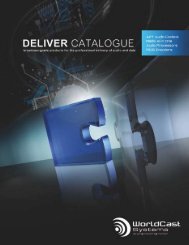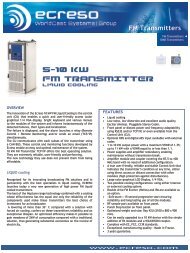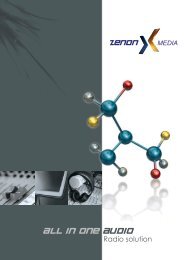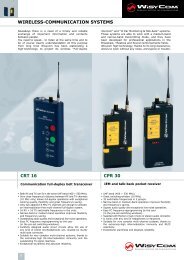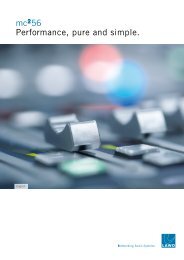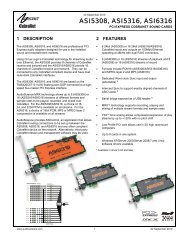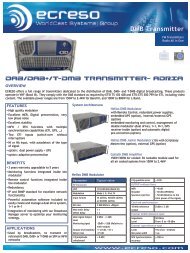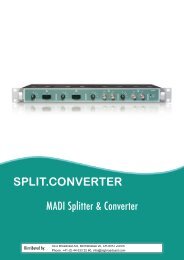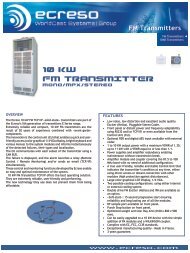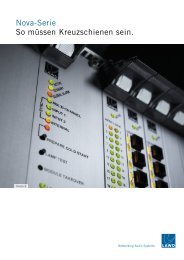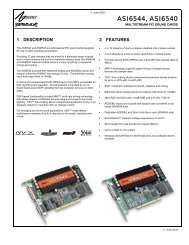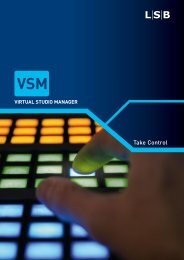Omnia ONE Brochure - Web Quality - Omnia Audio
Omnia ONE Brochure - Web Quality - Omnia Audio
Omnia ONE Brochure - Web Quality - Omnia Audio
Create successful ePaper yourself
Turn your PDF publications into a flip-book with our unique Google optimized e-Paper software.
10 | OMNIA<strong>ONE</strong><br />
Sensus Overview<br />
Until now, digital signal processing has been a more precise numeric implementation of well-known analog methods. Even<br />
relatively recently designed digital audio processors couldn’t veer too far from the comparatively simplistic concepts that analog<br />
dynamics processing had utilized...until now!<br />
Extremely high power DSP chips have become available and at relatively low cost, and they make it possible to build smarter and<br />
more complex processing algorithms that were too difficult or impossible (or too expensive) to do in the past.<br />
Running on a platform of the latest high power DSP chips, the <strong>Omnia</strong> <strong>ONE</strong> and our new Sensus® technology takes digital dynamics<br />
processing into a completely new frontier. Instead of the two-dimensional static processing architecture of the past, Sensus®<br />
enables the audio processor to modify its own architecture in real time and in response to ever-changing program content.<br />
Simply stated, Sensus® has the ability to “sense” what must be done to a signal in order to best tailor it for output to a codec. As<br />
program content changes, it “rearranges the algorithms” to accomplish this goal. The uniqueness of the Sensus® technology makes<br />
it highly suitable not only for codec pre-conditioning (or provisioning), but also for a range of other highly specialized signal processing<br />
challenges. The following is a discussion of how Sensus® technology can be applied to a coded audio environment.<br />
Codec Provisioning<br />
The codec is now a common denominator in the world of audio and broadcasting. Digital broadcasting (HDTV, HDRadioR, DAB,<br />
DRM), podcasting, webcasting, cellcasting, and downloadable music files all employ a form of codec-based data compression in<br />
order to minimize the bandwidth required to transmit audio data. The necessarily low bitrates utilized by these mediums presents<br />
a tough challenge for any audio processor used prior to a codec.<br />
Traditional dynamics processors are designed to fulfill the requirements of a medium where the functions are generally static. That<br />
is, they’re well suited to the rather simplistic peak control and bandwidth limiting methods required for analog broadcasting, as<br />
well as for the signal normalization techniques used in recording and mastering.<br />
<strong>Audio</strong> codecs on the other hand are moving targets - each codec algorithm has its own set of artifacts. Not only does the sonic<br />
quality vary depending on the algorithm and bitrate used, but more importantly they vary in their ability to mask their own coding<br />
action. This is why we call it a ‘moving target’ , and is why conventional audio processors fall short in a coded audio environment<br />
and can actually make coding artifacts worse due to their inability to adapt appropriately to the changing operation of the codec<br />
as the program content changes.<br />
Prior art in audio dynamics processing could only address some of the challenges of provisioning audio for coding. This hurdle<br />
existed because the codec adapts to the incoming program (so as to generate the least amount of output data representing the<br />
input audio) causing the sonic artifacts generated by the process to continually change. Unless the audio processor can predict<br />
these changing characteristics of the codec, it can’t possibly create output audio that is perfectly tailored for the coding process.<br />
Conventional processors utilize rather simplistic high frequency limiters and fixed low pass filtering that does not change with<br />
the program material. When these less intelligent processors feed a codec the audio might sound acceptable one moment and<br />
offensive the next. Because they cannot “know” what the codec will do next, the result is over-compensated, dull and lifeless audio...<br />
audio that still contains objectionable codec-generated artifacts!<br />
<strong>Omnia</strong> <strong>ONE</strong> Multicast and HD® Radio<br />
The advent of HD Radio R has introduced the capability to transmit multiple program streams, or “Multicast”, within a single 96kbps<br />
digital broadcast data channel. To facilitate this, multicast relies on the use of codecs with comparatively low bitrates. A broadcaster<br />
can choose to transmit a number of multicast channels and select the bitrate for each one. However, the more multicast channels<br />
there are, the lower the bitrate each channel must have in order for them to all fit within thetotal available bandwidth.<br />
In the very near future, many low bitrate multicast audio channels might exist. To achieve maximum sound quality, the kind that<br />
attracts and holds listeners, those channels will need specialized dynamics processing capable of creating great sound regardless<br />
of program content and bitrate. They will need Sensus®.<br />
| <strong>Omnia</strong> <strong>ONE</strong> | See <strong>Omnia</strong><strong>Audio</strong>.com/one for more details.



